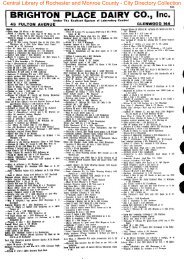The Farm Journal Illustrated Rural Directory of Monroe County, New ...
The Farm Journal Illustrated Rural Directory of Monroe County, New ...
The Farm Journal Illustrated Rural Directory of Monroe County, New ...
Create successful ePaper yourself
Turn your PDF publications into a flip-book with our unique Google optimized e-Paper software.
Central Library <strong>of</strong> Rochester and <strong>Monroe</strong> <strong>County</strong> · <strong>County</strong> Directories Collection<br />
CLASSIFIED BUSINESS DIRECTORY<br />
them after turning the fowls out and<br />
keep closed for an hour or two. Pour<br />
a gill <strong>of</strong> turpentine and a gill <strong>of</strong> carbolic<br />
acid over a peck <strong>of</strong> lime and let it become<br />
slaked, then scatter freely over the<br />
interior <strong>of</strong> houses and coops and about<br />
the yards.<br />
For the first stages spray the affected<br />
flock while on the roost or in the coop<br />
with a mixture <strong>of</strong> two tablespoonfuls <strong>of</strong><br />
carbolic add and a piece <strong>of</strong> fine salt as<br />
big as a walnut in a pint <strong>of</strong> water. Repeat<br />
two or three times a week. Or, if<br />
a dry powder is preferred, mix equal<br />
I arts <strong>of</strong> sulphur, alum and magnesia and<br />
dust this in their nostrils, eyes and throat<br />
with a small powder gun. <strong>The</strong> nasal<br />
cavities should be kept open by injecting<br />
with a glass syringe or sewing machine<br />
oil-can a drop or two <strong>of</strong> crude petroleum.<br />
A little should be introduced also<br />
through the slit in the ro<strong>of</strong> <strong>of</strong> the<br />
mouth. Give sick birds a dessertspoonful<br />
<strong>of</strong> castor oil two nights in succession,<br />
and feed s<strong>of</strong>t food <strong>of</strong> bran and corn<br />
meal seasoned with red pepper and powdered<br />
charcoal. A physician advises<br />
the following treatment: hydrastin, 10<br />
grains; sulph. quinine, 10 grains; capsicum,<br />
20 grains. Mixed in a mass with<br />
balsam copaiba and made into twenty<br />
pills; give one pill morning and night;<br />
keep the bird warm and inject a saturated<br />
solution <strong>of</strong> chlorate potash in nostrils<br />
and about 20 drops down the throat<br />
PIP, so-called, is not a disease but only<br />
a symptom. <strong>The</strong> drying and hardening<br />
<strong>of</strong> the end <strong>of</strong> the tongue in what is<br />
called "pip" is due to breathing through<br />
the mouth, which the bird is compelled<br />
to do because <strong>of</strong> the stoppage <strong>of</strong> the<br />
363<br />
nostrils. By freeing the natural air<br />
passages the tongue will resume its normal<br />
condition.<br />
DIPHTHERIA is a contagious disease.<br />
<strong>The</strong> first symptoms are those <strong>of</strong> a common<br />
cold and catarrh. <strong>The</strong> head becomes<br />
red and there are signs <strong>of</strong> fever,<br />
then the throat fills up with thick, white<br />
mucus and white ulcers appear. <strong>The</strong><br />
bird looks anxious and stretches its neck<br />
and gasps. When it attacks young chicks<br />
it is frequently mistaken for gapes.<br />
When diphtheria prevails, impregnate<br />
the drinking water with camphor, a teaspoonful<br />
<strong>of</strong> the spirits to a gallon <strong>of</strong><br />
water, and fumigate the house as recommended<br />
for roup.<br />
Spray the throat with peroxide <strong>of</strong><br />
hydrogen or with this formula: 1 ounce<br />
glycerine, 5 drops nitric acid, 1 gill water.<br />
To treat several birds at once with medicated<br />
vapor, take a long box with the<br />
lid <strong>of</strong>f, make a partition across and near<br />
to one end and cover the bottom with<br />
coal ashes. Mix a tablespoonful each<br />
<strong>of</strong> pine tar, turpentine and sulphur, to<br />
which add a few drops, or a few crystals,<br />
<strong>of</strong> carbolic acid and a pinch <strong>of</strong><br />
gum camphor. Heat a brick very hot,<br />
put the fowls in the large part and the<br />
brick in the other, drop a spoonful <strong>of</strong><br />
the rcbeture on the brick and cover<br />
lightly to keep the fumes in among the<br />
patients. Watch carefully, as one or two<br />
minutes may be all they can endure. Repeat<br />
in six hours if required.<br />
CROP-BOUND.—<strong>The</strong> crop becomes much<br />
distended and hard from obstruction <strong>of</strong><br />
the passage from the crop to the gizzard<br />
by something swallowed; generally,<br />
it is long, dried grass, a bit <strong>of</strong> rag or<br />
rope. Relief may sometimes be afforded<br />
by giving a tablespoonful <strong>of</strong><br />
sweet oil and then gently kneading the<br />
crop with the hand. Give no food, except<br />
a little milk, until the crop is<br />
emptied. Wet a tablespoonful or more<br />
<strong>of</strong> pulverized charcoal with the milk and<br />
force it down the throat. Should the<br />
crop not empty itself naturally pluck a<br />
few feathers from the upper right side<br />
<strong>of</strong> it and with a sharp knife make a cut<br />
about an inch long in the outer skin.<br />
Draw this skin a little to one side and<br />
cut open the crop. Remove its contents,<br />
being careful not to miss the obstruction.<br />
Have a needle threaded with<br />
white silk ready, and take a stitch or<br />
two in the crop skin first, then sew up<br />
the outer skin separately. Put the patient<br />
in a comfortable coop, and feed<br />
sparingly for a week on bran and meal<br />
in a moist state, and give but little<br />
water.<br />
SOFT OS SWELLED-CROP arises from<br />
lack <strong>of</strong> grit, or from eating soggy and<br />
unwholesome food. <strong>The</strong> distended crop<br />
contains water and gas, the bird is feverish<br />
-and drinks a great deal. By holding;<br />
it up with its head down the crop will<br />
usually empty itself. When this is done<br />
give teaspoon doses <strong>of</strong> charcoal slightly<br />
moistened twice at intervals <strong>of</strong> six hours.<br />
Restrict the supply <strong>of</strong> water and feed<br />
chopped onions and s<strong>of</strong>t feed in moderation.<br />
EGG-BOUND, DISEASES OF THE OVIDUCT.<br />
Overfat hens are <strong>of</strong>ten troubled in this<br />
way. Forcing hens for egg production<br />
will sometimes break down the layiner<br />
machinery Give green food, oats, little*<br />
corn, and no stimulating condiments.<br />
Let the diet be plain and cooling in its
















